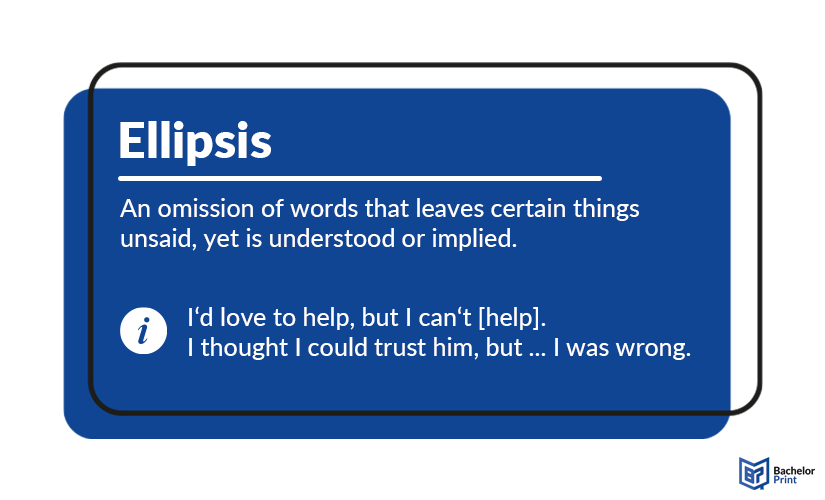
Ellipsis, a concept regularly encountered in academic writing, is an essential stylistic device that plays a significant role in written and spoken communication. To fully grasp the application and importance of ellipses, it’s crucial to explore various examples and contexts in which they are employed. Understanding this enhances one’s writing skills and enriches the reading experience, offering insights into the nuanced ways in which authors and scholars communicate their ideas.
Definition: Ellipsis
The term “ellipsis,” or “ellipses” when talking about the plural, encompasses a more complex and nuanced concept than its simple appearance of three dots (…) might suggest. The meaning of an ellipsis extends beyond its basic definition as a series of dots indicating an omission. It is a grammatical and rhetorical device used in both written and spoken language, serving multiple purposes.
A normal ellipsis represents the omission of words. This is particularly useful in academic and formal writing for brevity, especially when quoting texts. By using ellipses, a writer can skip parts of a quote that are less relevant to their point, focusing on the essential segments without altering the original meaning.
While the term “ellipsis” is the most formal descriptor of this device, it is also colloquially referred to as “dot-dot-dot.” Other synonyms for the word include suspension point, points of ellipsis, and periods of ellipsis. In typography, the ellipsis character is a single glyph (…) that differs from writing three period marks in a row.
When using an ellipsis as a stylistic device, it refers to the omission of parts of a sentence or idea, not through punctuation, but through the structure of the language itself. It’s a stylistic choice that leaves certain things unsaid, relying on the context and the audience’s ability to infer the missing information. This can enhance the expressiveness, impact, or efficiency of communication.
In summary, ellipses are versatile and subtle tools for writing and language, used to condense, imply, and convey emotions or thoughts in a way that complete sentences may not. Its proper use enriches communication by adding layers of meaning or facilitating clarity and conciseness.
In this quote, the mark of omission at the end suggests that there might be more to the statement or invites the reader to ponder the consequences of not living together as brothers.

Etymology
The word comes from the Ancient Greek word “élleipsis,“ meaning “leave out” or “autumn short.” The Greek term is derived from “elleipein,“ which is a combination of two parts:
- “en-“ — a variant of “in-,“ meaning “in” or “on”
- “leipein” – meaning “to leave” or “to lack”
The notion of “leaving out” or “omission” is central to the meaning of the word.
Over time, as the concept travelled through languages, the term evolved to “ellipsis” in English. It retained its original meaning of omission or something left out. This etymology is closely tied to the use of ellipsis in language and literature, where it signifies the intentional omission of a part of the text or speech, symbolized by a series of dots (…). The adaptation of this term into English kept the essence of its Greek roots.
Note: A single ellipsis (singular) consists of one group of three dots, while two or more groups of three dots are called “ellipses” (plural).
How to use ellipses in writing
Effectively employing horizontal ellipses in writing necessitates comprehending not only their function but also the subtleties of their application. It is a versatile tool that can enhance your writing in various ways. Using ellipses can add depth and clarity to your text, whether you’re working on an academic essay, a narrative for a novel, or a research paper. In this section, we shall examine the guidelines as well as provide plenty of varying examples of ellipsis to illustrate the utilization. Note that this section’s focus does not lie on academic writing. If you are keen to learn more about those three dots in writing, as well as how square brackets and ellipses are connected, read on.
Indicating omission
The primary purpose is to indicate the omission of specific words or phrases from a quoted text. This is especially useful for academic writing and journalism, where conciseness is crucial and only the most pertinent portions of a quote are required. A quotation mark and an ellipsis can be used to skip the beginning of a quote in your writing.
Creating suspense or dramatic effect
In the realm of creative writing, ellipses are employed to instil a sense of suspense, anticipation, or drama. By evoking a pause, the author encourages readers to speculate on what’s next or to imagine the gaps in the text.
Signifying a pause or hesitation
An unbracketed ellipsis can show a pause in speaking or thinking, especially during conversations. This mimics the inherent rhythm of spoken language, where individuals frequently pause to contemplate, hesitate, or pause mid-sentence.
Implying unfinished thoughts or trailing off
In both fiction and non-fiction writing, an ellipsis can indicate that someone’s thought is incomplete or that they deliberately left something out. The speaker’s uncertainty, reluctance to continue, or the end of the thought can be reflected in this stylistic choice. Occasionally, the ellipsis foregoes an unfinished sentence.
in Your Thesis
Ellipsis in academic writing
The rules for using ellipses can vary depending on the academic style guide you are following. Normally, ellipses are used in academic writing to indicate that something has been left out in a direct quote. Some of the most common style guides and their rules for ellipses include:
- APA Style uses ellipses to indicate omissions in the middle of a sentence
- For omissions between sentences, use a period followed by ellipses
- Space your ellipses with a space before and after:” … “
- MLA uses three periods with no spaces in between for omissions within a sentence: “…”
- For omissions between sentences, include a space before the first period
- Square brackets must be placed if there is no pause indicated in the original quote
- Chicago Style recommends using three spaced periods for ellipses
- It also suggests using a period before the ellipsis to indicate the omission of the end of a sentence
In each case, it’s important to ensure that the use of ellipses does not alter the original meaning of the quote. Furthermore, ellipses should not be used at the beginning of a quote, only in the middle or at the end. Always check the specific guidelines of the style guide you are using for your academic work, as there might be variations or additional specifications.
Differences between British and American English
There are differences in how ellipses are used in British English vs. American English, primarily in terms of spacing and punctuation. Especially for people whose mother tongue is not English, using ellipses in the different English variants may be difficult to remember. This may lead to confusion over ellipsis, which is why we provide a table below with the most essential differences.
| British English | American English |
| There is usually a space between each dot (. . .) | Involves three dots with no space between each dot (…) |
| Often a space before and after the ellipsis | Often a space before and after the ellipsis |
| The play's the thing . . . the conscience of the king. | The play's the thing … the conscience of the king. |
Types of ellipsis
This paragraph refers to using ellipses not as the literal three dots, but rather as a rhetorical device. There are several types of ellipses, each with its specific use and rules. The primary types include:
This involves omitting a verb (and sometimes other elements) in the second of two parallel clauses. The missing parts are understood from the context.
Similar to gapping, instead of omitting a verb, it involves omitting a verb phrase, leaving a remnant like an auxiliary or modal verb.
This type is also called bare argument ellipsis and omits most of a clause, leaving only a bare argument or a negation. It usually occurs in coordinate structures.
Here, the verb phrase is omitted, often following an auxiliary or modal verb. This is common in conversational English.
This involves the omission of a noun phrase, typically when it’s clear from the context what the noun phrase refers to.
Special sort of ellipsis
These terms refer to visual representations of ellipses in writing, each serving a specific purpose.
- Four dot ellipsis: This is a less common form that consists of four spaced dots followed by a period (….). It is typically used to indicate the omission of the end of a sentence before the start of another sentence.
- Extended ellipsis: This involves more than three dots. It may be used for various stylistic purposes, such as indicating a longer pause or a larger omission of text. The number of dots in an extended ellipsis can vary depending on the writer’s intention and the context. However, it’s less formal and not typically used in standard written English.
- ✓ Free express delivery
- ✓ Individual embossing
- ✓ Selection of high-quality bindings
FAQs
It is a punctuation mark consisting of three dots (…). It’s used to indicate the omission of words in a text, a pause in speech, an unfinished thought, or a trailing off into silence. Ellipses can also be used to build suspense or imply something left unsaid.
An ellipsis is used to indicate omitted material in a quotation, a pause in dialogue, or an unfinished thought.
An ellipsis in writing carries out four functions: to indicate omitted words, create suspense, show an unfinished thought, or signify a pause in speech.
Yes, an ellipsis is represented by three consecutive dots (…).
